Kanazawa > Toyama > Takayama

A week into the trip and starting Day Two of the Rail Pass Tour, a 7:09 departure from Kanazawa precluded any thought of breakfast before heading to the station.
On the way out of the city, on a bleak morning which presented no chance to see whether recent precipitation had managed to clear the ever-present haze, there were obvious signs of recent and fairly substantial rainfall, which, given our experiences of the day before was hardly earth-shattering news. Kanazawa has a well-deserved reputation for wet weather.
After we’d left the outskirts of Kanazawa we passed through an agrarian landscape, with a misty haze covering the forested hilltops. Suited salary-men boarded the train at some stations and I couldn’t help noticing that there were some upmarket homes scattered through the rural villages.
Conditions made it difficult to see the snow that I was sure capped the mountains away to our right, and as we moved away from the coast the land on the left hand side started to rise, though again it wasn’t possible to get a clear view of the peaks.
At Toyama we had a slight degree of difficulty finding Platform 3, which wasn’t particularly well signposted, but eventually discovered that the next leg of the journey involved on an upmarket version of the old-fashioned rail motor.
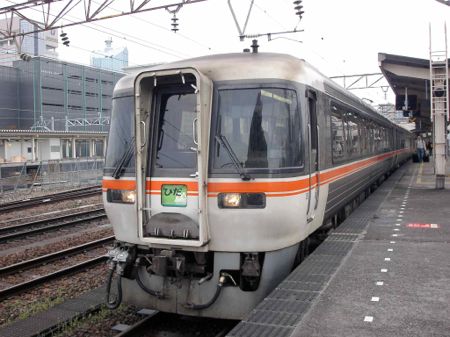
Once aboard, we found our seats in the first carriage. It was obvious, as we gazed through the picture windows that gave a generous view to the front and both sides of the train, we were travelling a particularly scenic route.
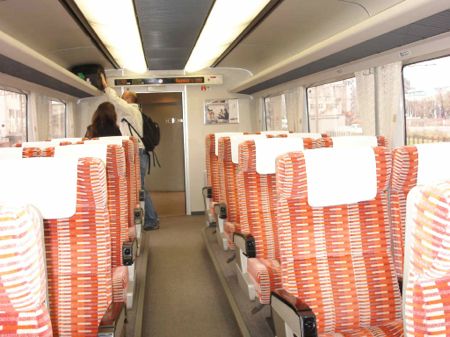
The misty conditions were far from ideal for sightseeing, but gave a feeling of travelling in an enclosed world as we headed upcountry past increasingly wilder streams boosted by recent rainfall. Despite the rain, many of the trees still held cherry-blossom, which suggested steady drizzle rather than the sort of downpour that would knock the flowers off the branches.
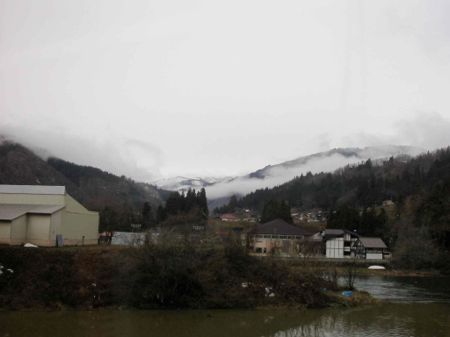
As we climbed into the mountains the mist closed in more tightly. Large power pylons in the valley beside us suggested the presence of nearby hydroelectric stations, We passed through frequent tunnels, skirting sudden canyons and waterfalls. As we made a lengthy stop at a little place called Inotani I looked out over forested mountains that evoked images of hermits and Zen poets in the mist.
Moving on through Sugihara, we passed into an area where there were patches of snow on slopes not far above the line. By this point we were following the river valley, almost at river level with the highway on the other side of the stream protected by a roof supported by lines of pillars.
As we rolled through Sakakami I gave up on writing in the journal, which I’d had open on the folding tabletop, deciding that the distraction of scribbling the odd brief observation was getting in the way of enjoying the scenery.
Approaching Takayama I couldn’t help noticing the houses looked to be of much the same construction as those further down, and guessed that they’d have to be very well insulated if the occupants were going to make it through what would have had to be harsh winters.
My suspicions about the temperature in these parts were confirmed as we alighted in Takayama just after nine o’clock in conditions colder than a mother-in-law’s kiss. We transferred the suitcase to the hotel, then headed back to the station precinct to catch the bus to the Hida Folk Village, where we spent a couple of hours wandering through buildings rescued from river valleys that had been flooded to provide the water supply for hydroelectric schemes.
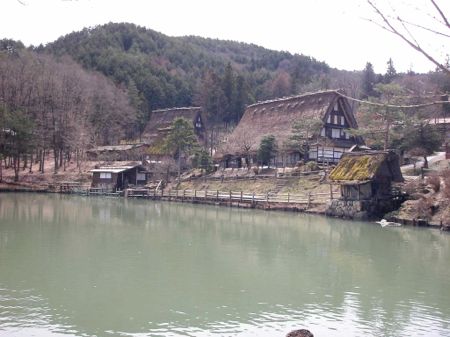
The timber houses themselves weren’t really all that old, not going back much further than the middle of eighteenth century, but were the sorts of places where ordinary people would have lived.
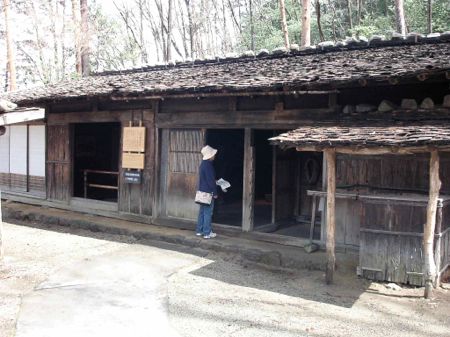
The buildings came from a variety of sources, and represented a range of occupations and social classes. There were farmhouses where the upper storeys were devoted to silkworm cultivation, a priest’s home, a village head man’s house where the walls could be removed to make a room large enough for public meetings, and a woodcutter's hut as well as a way-station from a main road.
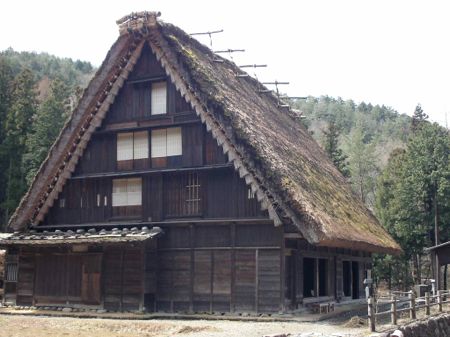
And one building erected as a residence for a wealthy landowner.
While the odd casual onlooker might be tempted to dismiss the place as just another tourist trap, it certainly looked to me like a genuine attempt to preserve aspects of the area’s traditional lifestyle, with streams of cold melt-water flowing downhill to power water mills. Here and there isolated patches of snow remained in hollows protected from the springtime sun.

Each of the buildings, for example, was heated, if that’s the right word to use when you’re talking about a few burning coals in the central living area, by fire rather than electricity, and I couldn’t help but wonder how the original occupants coped with winter temperatures that reached below minus twenty with two metres of snow on the roof.
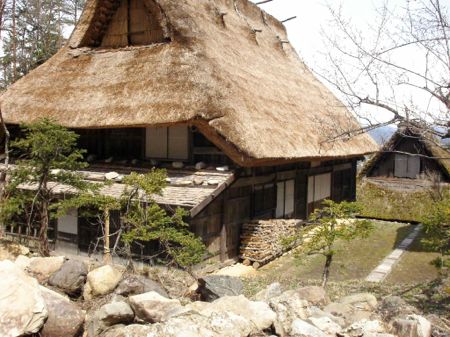
It is not, however, the sort of place to take kids who can’t tie up their own shoelaces, since venturing inside almost every building involves removing the footwear. In hindsight I wished I’d invested in a pair of Velcro-equipped joggers.
Two hours of wandering through heritage houses on an empty stomach meant that we weren’t going to wait till we got back to town to eat, and fortunately just outside the heritage village we found a restaurant serving noodles with char sieu pork, which I washed down with half a litre of Asahi beer. Before heading back to the bus stop for the return trip to town.
Having just missed one bus, we thought that the next one that pulled up might be able to deliver us to downtown Takayama, and it turned out that it was the next bus back to the station. There was one minor technicality. It wouldn’t be setting out on that route for another twenty minutes, since it had to complete a different loop around the town’s attractions.
The driver, thankfully, decided that although we were going to be heading back in twenty minutes, we might as well board the bus now, rather than stand around for the intervening period.
Which is what we did.
Once we’d returned to the station precinct it was still too early to book in to the hotel, so we took a stroll to Takayama Jinya, the central government official’s residence and administrative centre from the Edo period, and a very interesting place it turned out to be, although there wasn’t a great deal of information available in English and the English-speaking guide was unavailable that day.
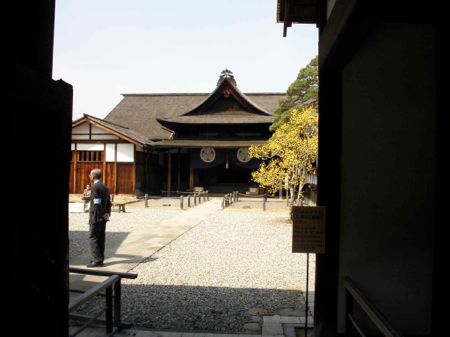
We wandered through the buildings at the same time as a group of Japanese visitors with an own-language guide. Judging by the audience reaction, if the English-speaker is half as good as the Japanese counterpart, his guests would be in for an entertaining time.
From Takayama Jinya we headed across the river to the Sanmachi Traditional Buildings Preservation area, and the old private houses. Unfortunately, straight after we arrived, the camera decided it had had enough for the moment, prompting us to use the current visit as a preliminary reconnaissance and to wander back in the morning with a recharged camera for a few photographic memories.
Back at the hotel we took it easy until dinner time, when we faced a minor dilemma. Takayama is famous for Hida beef, and we decided that was the preferred option for the evening meal. The only problem was deciding which particular venue to opt for.
We took a preliminary wander around the area just west of the hotel, where there were a couple of interesting possibilities, and eventually chose Yamatake-Shōten, the one closest to home.
Although it didn’t seem like it straight away, it turned out to be an inspired choice.
The place was a combined retail outlet for a beef-raising operation with a sideline offering a cook-it-yourself service.
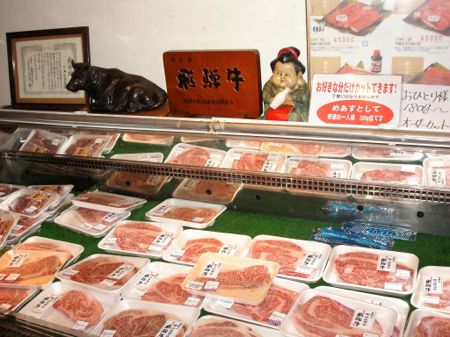
Once we’d selected the particular parcel of beef we’d like for dinner, we picked out a range of vegetables to accompany it and moved over to our table, where some hot coals had been placed under the metal grill in the middle of the table.
The proprietor got us started on the cooking process, then left us to it with a bottle of 2006 Cotes du Rhone to keep us occupied while we cooked our dinner piece by piece. Definitely delicious.
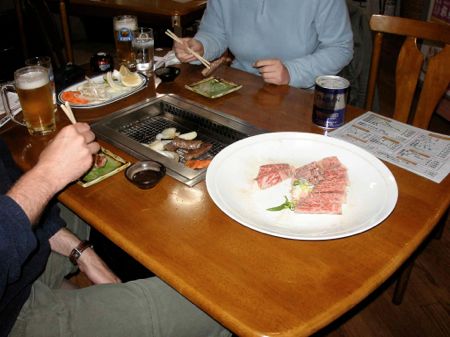
The beef, however, would never pick up a heart smart tick in Australia and definitely wouldn’t appeal to someone fanatical about trimming the fat off their steak.
We were finishing off the bottle when the proprietor returned to check everything was under control. Since it was, and other customers were conspicuous by their absence, he stayed to talk to ‘Er Indoors (English being effectively non-existent). He’s obviously someone with great pride in his home town and its regional culture, since he proceeded to bring out and unroll a number of posters about the forthcoming Takayama Festival the following week.
Although I was, more or less, an uninvolved bystander unable to catch any of the commentary the next ten minutes or so were one of the absolute highlights of the whole fortnight.
Each of the posters had obviously been rolled and unrolled countless times and showed signs of wear and tear. Someone who was doing this sort of thing for a living, or as a regular part of his day to day business would have gone out, gathered a collection of these posters, had them laminated and would, more than likely have worked up a little PowerPoint presentation that he could leave running on a laptop he could leave running while he attended to other more pressing matters.
Our host, on the other hand, excused himself several times while he attended to other matters, returning after each interruption to talk about something he obviously takes great pride in.
One interruption involved getting a young Spanish couple at the table next door started on the cook-it-yourself caper, attempting to communicate with them in extremely limited English (I presumed his Spanish is about as good as mine, which is non-existent) while commenting over his shoulder to ‘Er Indoors in Japanese. Amazing.
After that spot of entertainment there was nothing for it but to stroll the fifty metres back to the hotel, pick up a couple of cans of beer from a vending machine and retire for the night.

